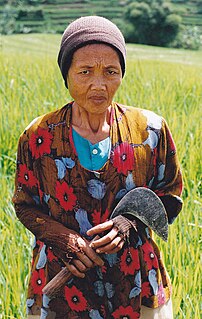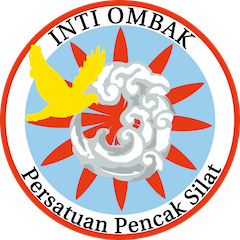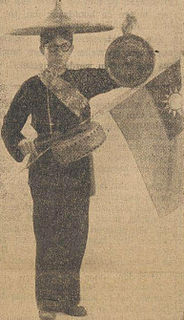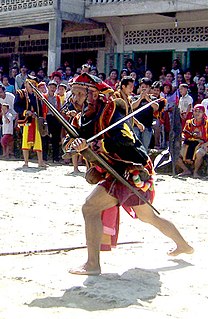History
Raden Mas Soebandiman Dirdjoatmodjo, also known as Pak Dirdjo, was born on January 8, 1913 in the Paku Alam Palace, Yogyakarta, Indonesia. He is the first son of Raden Mas Pakoe Soedirdjo, great-grandfather of Paku Alam II. When he was 9 years old he mastered the palace's martial arts and was authorized to train his friends in the palace. In addition to learning Pencak silat, he also learned traditional dance at the Palace of Paku Alam and became friends with Wasi and Bagong Kussudiardja.
In his childhood, Pak Dirdjo was called Soebandiman or Bandiman by his friends. He w to learn more Pencak silat and after he graduated from Hollands Inlandsche Kweekschool (HIK, teacher training school), he left Yogyakarta to begin his journeys without taking any logistics into account.
The first place he visited was Jombang, East Java. Thus, he learned Pencak silat with K.H. Hasan Basri. He also deepened his spirituality at Tebuireng Islamic Boarding School. To support his life, he worked in a sugar factory in Peterongan. Having had a hard training with K.H. Hasan Basri, he traveled to Solo, Central Java, and underwent more Pencak silat training from Sayid Sahab. He also learned spiritual aspects from his grandfather, Ki Jogosurasmo.
He then traveled to Semarang, Central Java. There he learned Pencak silat from Soegito with Setia Saudara style. From there he went to Cirebon after transit in Kuningan, West Java. Here he learned another Pencak silat and spiritual aspects do not get enough to always draw knowledge from various teachers. In e also learned Minangkabau pencak silat and Aceh pencak silat.
His willingness to combine and process a variety of Pencak silat that he learned made him not tired of learning. Switching his teacher meant learning new things and increase knowledge he feels less. He was sure, if everything was done properly and based on good intentions, then God would guide him to achieve his goals. He began to draw on his own Pencak silat. Pak Dirdjo then settled in Parakan, Central Java, and open a pencak silat school with name Eka Kalbu, which means "one heart".
In the midst of training, he met with a master of Chinese Kuntao with Siauw Liem Sie (Shaolinsh i) style, his name is Yap Kie San. Yap Kie San is one of the grandchildren pupils of Louw Djing Tie through Hoo Tik Tjay. According to historical records, Louw Djing Tie is a legendary martial arts master, both in China and in Indonesia, and one of the major figures who carried Chinese martial arts to Indonesia. In the martial arts world, Louw Djing Tie is nicknamed Garuda Emas Dari Siauw Liem Pay (The Golden Eagle from Shaolin). Currently, successor students of Louw Djing Tie in Indonesia continuing Garuda Ema's kungfu school.
Pak Dirdjo which to learn a science regardless of age and ethnicity and studied martial arts originating from the monastery Siauw Liem (Shaolin) is from Yap Kie San for 14 years. He was accepted as a student is not in the normal way but through battle friendships with Yap Kie San's students. See the talent Pak Dirdjo, Yap Kie San moved to accept it as a student.
Various trials and training he lived with perseverance until finally reached the summit of martial arts training from Yap Kie San. Yap Kie San's students can hold only six people, of whom there are two people who are not Chinese people, are Pak Dirdjo and Raden Brotosoetarjo who later founded a Pencak silat martial arts style with name Bima (Budaya Indonesia Mataram). With the provision obtained during go abroad and combined with Siauw Liem Sie martial arts received from Yap Kie San, Pak Dirdjo began to formulate a science that has mastered it.
After being satisfied to go abroad, he returned to his homeland, Yogyakarta. Ki Hajar Devantoro (Indonesia Education Father), Pak Dirdjo's uncle, asked Pak Dirdjo to teach Pencak silat in the Taman Siswa College in Wirogunan. [3] In the midst of busy teaching Pencak silat in Taman Siswa, Pak Dirdjo get a job as Magazijn Meester in the sugar factory in Powered.
In 1947 in Yogyakarta, Pak Dirdjo appointed civil servants in the Ministry of Education and Culture, Section of Pencak Silat, which is headed by Mochammad Djoemali. Based on his mission to develop Pencak silat, Pak Dirdjo open Pencak silat courses through an official to the public. He also asked to teach at the Himpunan Siswa Budaya, a student activity unit in UGM (Universitas Gadjah Mada). His students are UGM students at the beginning of the establishment of the campus. Pak Dirdjo also opened a Pencak silat course in his office. Some of Pak Dirdjo's students at that time is Ir. Dalmono, Prof. Dr. Bambang Suyono Hadi and R.M. Moediono Probokusumo who were in the family of Perisai Diri also known as Mas Wuk.
In 1954 Pak Dirdjo conjunct to the East Java Provincial Cultural Office, Pencak Silat Affairs. His disciples in Yogyakarta, whether practicing at UGM and outside UGM, merge into one container HPPSI (Himpunan Penggemar Pencak Silat Indonesia), chaired by Ir. Dalmono.
In 1955, he moved to the city of Surabaya. With the same task, which was to develop and disseminate the Pencak silat as a culture of Indonesia, Pak Dirdjo open Pencak silat courses are held at the Cultural Office of East Java in Surabaya. Assisted by Imam Ramelan, he founded the Pencak silat courses with the name "Perisai Diri" on July 2, 1955. [1]
His students in Yogyakarta was then adapt as a named set of Perisai Diri silat. The disciples of Eka Kalbu ever established by Pak Dirdjo still in touch with him. They are scattered in Banyumas, Purworejo and Yogyakarta. This silat school is then not grown, but melted into Perisai Diri silat, as HPPSI in Yogyakarta. One teacher makes this college melting becomes easy.
The experience gained during wander and Siauw Liem Sie martial arts are mastered then pour in the form of techniques appropriate to the needs and capabilities of the human anatomy, without any element of rape motion. Everything went naturally and can be proven scientifically. With the motto Pandai Silat Tanpa Cedera (mastermind the silat without injury), Perisai Diri accepted by all walks of life to learn a martial art.
In 1969, a Pak Dirdjo's student, Dr. Suparjono, S.H., M.Si., became the staff of council PB PON VII (7th Indonesian National Sports Week) in Surabaya. With inspiration from the sport organizations AD / ART (articles of association) in KONI (The National Sports Committee of Indonesia), Suparjono with Bambang Moediono Probokusumo, Totok Sumantoro, Mondo Satrio and other Dewan Pendekar members in 1970 preparing AD / ART Perisai Diri and the full name of the organization parried be approved "Keluarga Silat Nasional Indonesia Perisai Diri" abbreviated "Kelatnas Indonesia Perisai Diri". [4] Also discussed the Perisai Diri standard uniforms, which had been changed to black and white with the attribute level changed several times until the last as it is used today. Kelantan Indonesia Perisai Diri's logo is also made of the results of several Pak Dirdjo's student's proposals, namely the proposed picture of Suparjono, Both Sudargo and Bambang Priyokuncoro, which later proposal of Suparjono elected, then refined and completed by Pak Dirdjo.
In 1982, Pak Dirdjo lift 23 of his students became Pendekar. The pendekar is appointed directly by Pak Dirdjo is called Pendekar Historis. Pendekar Historis amounting to 23 person :
- Mat Kusen, from Surabaya.
- Dr. Suparjono, S.H., M.Si., from Surabaya.
- Drs. Noerhasdijanto, S.H., from Surabaya.
- Hari Soejanto, from Surabaya.
- F.X. Supi'i, from Surabaya.
- Ir. Nanang Soemindarto, from Surabaya.
- Prof. Dr. dr. Hari K. Lasmono, M.S., from Surabaya.
- Drs. Siaman, from Surabaya.
- Prof. Dr. M. Hidajat, Sp.O.T., from Surabaya.
- Drs. I Made Suwetja, M.B.A., from Denpasar.
- Arnowo Adji, from Tangerang.
- Yahya Buari, from Lamongan.
- Bambang Soekotjo Maxnoll, from Cimahi.
- Tonny S. Kohartono, from Surabaya.
- Mondo Satrio Hadi Prakoso, from Surabaya.
- Koesnadi, from Surabaya.
- Letkol Soegiarto Mertoprawiro, from Serang.
- Totok Soemantoro, B.Sc., from Klaten.
- Moeljono, from Nganjuk.
- Wardjiono, from Jakarta.
- Gunawan Parikesit, from Semarang.
- I Gusti Ngurah Dilla, from Surabaya.
- Ruddy J. Kapojos, from Surabaya.
Perisai Diri in other countries
On May 9, 1983, R.M. Soebandiman Dirdjoatmodjo die facing the Creator. [5] The responsibility for continuing Perisai Diri technique and training switch to the students that have now spread to all corners of the country and several countries in Europe, America and Australia. Under the coordination of Dr. Ir. Soetjipto, M.M., as Chairman of the Central Board, currently Kelatnas Indonesia Perisai Diri has branches in almost every province in Indonesia and has commissariat in 10 other countries. To appreciate his services, in 1986 the government of the Republic of Indonesia bestowed the title Pendekar Purna Utama for R.M. Soebandiman Dirdjoatmodjo.
In Australia, Kelatnas Indonesia Perisai Diri was developed in Brisbane in 1979 by Dadan Muharram, a Perisai Diri silat trainer from Bandung, West Java. Kelatnas Indonesia Perisai Diri growing rapidly in Australia with branches in various municipalities, such as Tarragindi, Kuraby, Logan, Ashmore, Burleigh Heads, Springbrook, Maleny, Nambour, Noosaville, Yandina, Gympie, Townsville, Ayr, Coffs Harbour, Newcastle, Moruya Heads, Melbourne, Adelaide, Perth, and others.
Kelatnas Indonesia Perisai Diri has had a presence in the Netherlands by Ronny Tjong A-Hung since 1979. Today Kelatnas Indonesia Perisai Diri has branches in Amsterdam, Hilversum, Maarssen, Nieuwegein, Utrecht, and others.
Otto Soeharjono M.S., moved to London in 1983 and founded the Kelatnas Indonesia Perisai Diri Commissariat United Kingdom. He became a pioneer of PSF UK (Pencak Silat Federation of United Kingdom).
Both Sudargo, one of the Pendekar of Perisai Diri who served as the Board of Development of Pencak Silat Sports PB IPSI, in 1996 commissioned by the government as Transportation Attache at the Indonesian Embassy in Tokyo, Japan. He established JAPSA (Japan Pencak Silat Association). Assisted by Soesilo Soedarmadji, he developed the Kelatnas Indonesia Perisai Diri Commissariat Japan.
Kelatnas Indonesia Perisai Diri branches are also spreading in Germany, Switzerland, Timor-Leste, France, USA, Sweden, and other countries.















